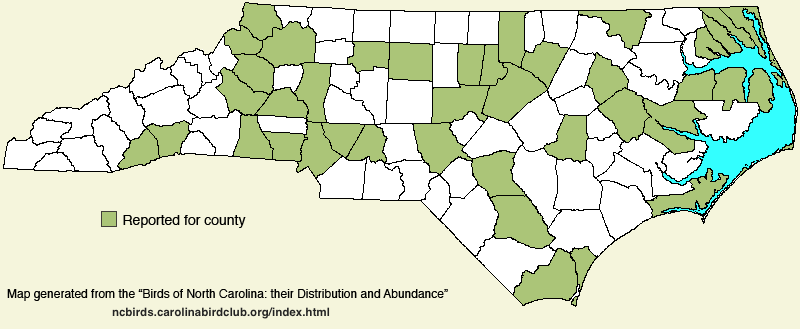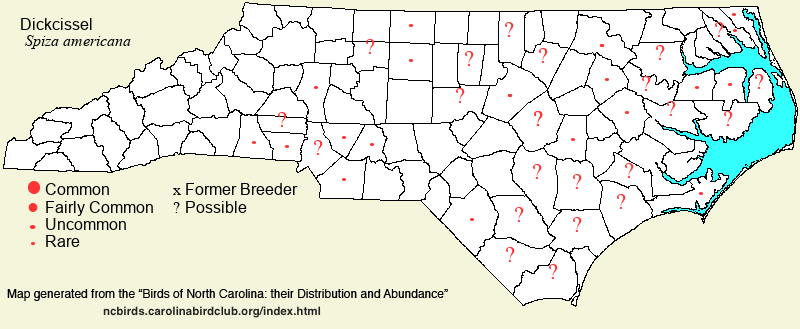 |
|
Dickcissel - Spiza americana CARDINALIDAE Members: | Search Common: Search Scientific: |
|
|
|||||||
| General Comments | Although there are numerous birds that are highly erratic wintering species in North Carolina and elsewhere in the East, no other bird is so erratic as a breeder in the eastern half of the continent as is the Dickcissel. In addition, the Dickcissel has no close relatives, and thus it not only is in its own genus, its taxonomic placement is completely unsettled. The species is common to abundant as a breeder in the Great Plains, but it has always been rare and erratic as a breeder east of the Appalachians. Also, it has little site fidelity, and a colony can appear one summer in a field and not be present the next year, even where conditions look similar; in the state, breeding occurs essentially in the Piedmont and Coastal Plain. As a migrant, it is known mostly from the immediate coast in fall (often detected by its buzzy call overhead, even without one seeing the bird). The species also "winters" in the state in small numbers, usually near the coast, but not enough to say it is a "winter resident". Favored breeding habitat is quite particular -- weedy fields with a moderate amount of tall, sturdy composites (and at times a few seedling woody plants) -- used for singing perches; grassy or weedy fields without sturdy singing perches are typically not suitable (though fences and fence posts can substitute for composites and saplings for singing perches). At other seasons, they can appear in a variety of weedy or brushy sites, often mixing with flocks of sparrows; a few even turn up at feeders. | ||||||
| Breeding Status | Breeder | ||||||
| NC BRC List | Definitive | ||||||
| State Status | SR | ||||||
| U.S. Status | |||||||
| State Rank | S2B | ||||||
| Global Rank | G5 | ||||||
| Coastal Plain | Sporadic and very local summer resident, and sparse winter visitor. In summer, very rare to rare over most of the province (and absent from coastal islands). Repeated breeding sites (several not current) have included North River Farms in central Carteret, fields between lakes Phelps and Pungo in Washington/Tyrrell, Cherry Hospital farms near Goldsboro, and the Voice of America Site B (Pitt). Nested (presumably) at Alligator River NWR (Dare) in 1988; two were singing there in Jul 2016, four were singing there in Jun 2017, and three singing there on May 2020. Poorly known migrant over the region, except rare to uncommon along the coast, most often on Hatteras Island. In winter, rare near the coast, and casual to very rare inland. In fall, mainly mid-Sep to early Nov; breeders often do not arrive until May. Peak counts -- all at North River Farms: 34 singing males, 1-6 Jun 2014; 32 (29 singing males), 2 Jun 2013; 30 singing males, Jun 2011; 28 (25 singing males), 19 May 2013; 27 (21 singing males), Jun 2005. Peak count of migrants -- 8 heard calling in flight, Run Hill State Natural Area (Dare), 15 Oct 2023. | ||||||
| Piedmont | Sporadic and very local summer resident, and very sparse winter visitor. In summer, rare and sporadic in the southwestern part of the region, especially Cleveland and Gaston, and very rare to locally rare elsewhere (such as north of Greensboro in Guilford and Rockingham). At other seasons, essentially very rare, but with records for all months, and many in winter. Mainly May, Jun, and Jul. Peak counts: 12, along Baldwin Road (Guilford), 17 May 2018; 11, along Benaja Road (Rockingham), 27 May 2018. | ||||||
| Mountains | Sparse transient; seldom in summer or winter. Despite many wide valleys with farmland at low elevations, there are no known breeding, or even suspected breeding, records. Generally, a very rare migrant in low elevation areas in the southern part of the region, and casual elsewhere. One at Valle Crucis Community Park (Watauga), 17 Oct 2016 was at a rather high elevation (over 3,000 feet) for the species. One at Warren Wilson College (Buncombe) on 21 Jun 2017 was notable for summer but there was no indication of nesting. Mainly early Apr to mid-May, and in Oct. One winter record: one at Brevard, 21 Nov - 14 Dec 2000. Peak counts: | ||||||
| Finding Tips |
From 2005 - 2018, the species has been easily found in summer at North River Farms, but this is a private area with limited public access. Otherwise, the best bests are in May and Jun at the Cherry Hospital farm lands near Goldsboro, and various fields northeast of Lake Phelps (which would require driving roads and looking for suitable fields), and several roads north of Greensboro. ** | ||||||
| Attribution | LeGrand[2024-02-11], LeGrand[2023-04-12], LeGrand[2022-12-23] | ||||||
| NC Map Map depicts all counties with a report (transient or resident) for the species. | Click on county for list of all known species. |
| NC Breeding Season Map Map depicts assumed breeding season abundance for the species. |  |